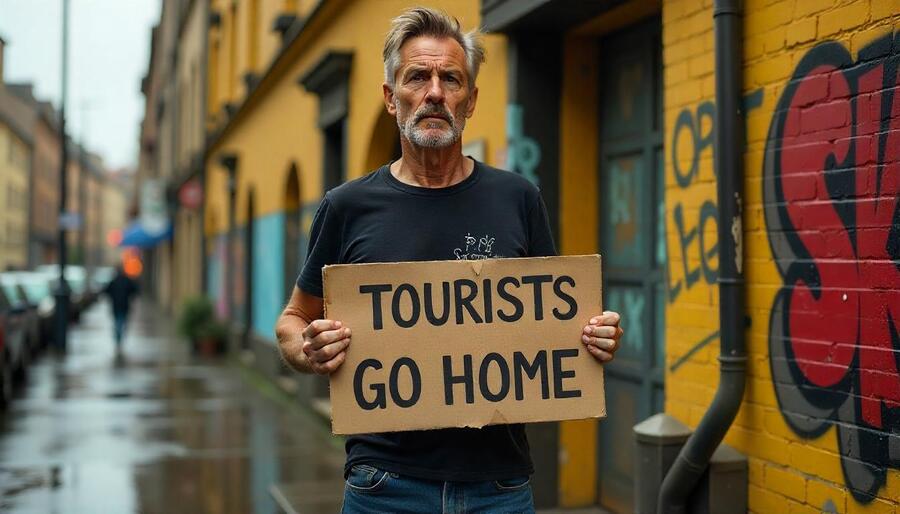≡-Spain, Italy, and Portugal Rocked by Massive Anti-Tourism Protests While France Manages Surging Visitor Influx with Strategic Tourism Distribution and Resilience Planning – Viral of Today
<> Viral of Today <>
Home » EUROPE » Spain, Italy, and Portugal Rocked by Massive Anti-Tourism Protests While France Manages Surging Visitor Influx with Strategic Tourism Distribution and Resilience Planning Thursday, July 17, 2025Now, Spain, Italy and Portugal are grappling with sweeping anti-tourism protests as angry locals push back against the growing pressures from rampant visitor numbers — such as rental housing shortages, cultural degradation and a strain on public services — fueled by the influx. That is the opposite of what is happening in France, which has welcomed record numbers of international tourists with little of the backlash it has generated elsewhere, thanks to its more strategic tourism redistribution, domestic tourism support and commitment to resilience planning that spreads visitors across a range of attractions, seasons and locations, lifting the pressure on its urban centers and cultural treasures.With sun-soaked hot spots in Southern Europe attracting millions of tourists from around the world every summer, a backlash of local frustration has become impossible to ignore. On June 15, 2025, some 20 cities throughout Spain, Italy and Portugal saw synchronized protests shine a light on the surging impact of overtourism. Protesters expressed anger about tourism-driven housing unaffordability, cultural degradation and out-of-control crowds at some of the world’s most iconic monuments.While these Mediterranean nations grapple with resident dissent, a different picture emerges in France. Despite hosting a record 100 million international visitors in 2024 and anticipating even higher figures in 2025, France has avoided large-scale protests and maintained a more balanced tourism narrative. This divergence raises critical questions: Why have Spain, Italy, and Portugal reached a boiling point, and how has France managed to sidestep the same level of backlash?The Southern European Uprising: A Pushback Against Mass TourismIn Spain’s Mallorca, thousands of demonstrators marched through Palma’s streets waving signs with striking slogans such as “Your wealth is our misery.” Similar scenes unfolded in Barcelona, Lisbon, and Venice. The protests, now an annual summer fixture, underscore a widening rift between the needs of local communities and the demands of a booming tourism economy.A central grievance among protestors is the proliferation of short-term vacation rentals through platforms like Airbnb, which has driven housing prices to unsustainable levels. Residents in central districts increasingly find themselves displaced as landlords prioritize lucrative tourist bookings over long-term tenants. Entire neighborhoods once brimming with local life have morphed into tourist enclaves devoid of their original character.This transformation has fueled a sense of exclusion, with residents feeling pushed out not just physically, but culturally. Many locals express the belief that their cities now cater exclusively to outsiders, while their own quality of life deteriorates under the weight of overcrowding, traffic congestion, and rising costs.Airbnb and the Hollowing Out of CommunitiesAirbnb has become a lightning rod in these discussions. Originally touted as a means of sharing underutilized housing, it has since morphed into a highly commercialized sector that dominates rental markets in tourist-heavy zones. In cities like Barcelona, entire apartment blocks are now dedicated solely to tourist accommodation.This shift has dire consequences. Housing availability plummets, prices skyrocket, and younger generations are increasingly priced out of the neighborhoods they grew up in. The result is a socio-economic divide between international visitors enjoying luxurious short stays and locals working service jobs to support the tourism infrastructure.Destruction Through OverexposureIt is not just housing that suffers. Cultural landmarks and natural sites across Southern Europe are buckling under relentless pressure. In Portugal and coastal Italy, beach ecosystems are deteriorating. In Spain, local advocacy groups like Menys Turisme, Més Vida (“Less Tourism, More Life”) warn that reckless visitor behavior and constant footfall are eroding the very destinations tourists come to admire.Similar concerns echo across national borders. In France, the world-renowned Louvre Museum recently faced an unprecedented crisis. A leaked memo from its director warned that the museum’s fragile structure and precious collections were under “physical strain” due to overcrowding. The institution, which welcomed 8.7 million visitors in 2024—double its intended capacity—has seen its staff go on strike to protest unmanageable workloads and deteriorating working conditions.France’s Tourism Boom: Record Numbers, Minimal ProtestsAlthough France welcomed an unprecedented 100 million tourists in 2024, marking a historic tourism rebound, it has largely sidestepped the wave of mass protests that have swept through neighboring Southern European nations. This disparity is partially rooted in the country’s historical relationship with tourism, particularly in Paris.Unlike Barcelona or Lisbon, Paris has long embraced international visitors as part of its identity. The 1889 Exposition Universelle, where the Eiffel Tower was unveiled to the world, played a pivotal role in establishing Paris as a premier international cultural and architectural showcase. This legacy has helped foster a sense of acceptance among Parisians, albeit with growing fatigue among older residents who remember a more tranquil city.The Power of Domestic TourismAnother factor behind France’s relative calm is the strong presence of domestic tourism. In 2024, domestic travel spending in France was double that of international tourism, indicating a more integrated and locally accepted visitor base. In contrast, Spain’s domestic and international spending figures were nearly identical, suggesting a higher reliance on foreign tourists.Domestic travelers tend to exhibit behaviors more aligned with local norms. They speak the language, understand cultural etiquette, and often visit friends or family. This cultural alignment reduces friction between residents and visitors and promotes a more harmonious tourism environment.Distributed Tourism: A Strategic AdvantageFrance also benefits from a diversified tourism model. While nearly half of all international tourists visit Paris, many are also drawn to attractions outside the capital. Disneyland Paris and the Château de Versailles alone attract 14 million and 7 million annual visitors, respectively. These sites draw crowds away from the city center, helping distribute foot traffic and ease pressure on iconic landmarks like the Louvre and Notre-Dame Cathedral.In contrast, Spain’s tourism remains heavily concentrated in beach resorts and coastal areas, especially during peak summer months. This seasonal intensity places immense stress on infrastructure and residents alike, leaving little room for sustainable management.Resilience Planning in Popular French DestinationsFrench destinations are proactively adapting to tourism pressures. On the Côte d’Azur, the island of Porquerolles has implemented a daily cap of 6,000 visitors to preserve its fragile ecosystem. In Brittany, the historic city of Saint-Malo is pivoting to a year-round tourism strategy to flatten seasonal spikes.These initiatives reflect an awareness of tourism’s dual-edged nature—it brings prosperity but also potential peril. By introducing policies that promote environmental protection and visitor dispersion, French municipalities aim to maintain tourism as an asset rather than a burden.Cultural vs. Commercial BalanceAnother key difference lies in how each country markets and develops its tourism sector. In France, tourism is often embedded within broader cultural narratives—visitors are encouraged to explore art, history, gastronomy, and countryside retreats. This elevates the tourist experience beyond pure consumption and encourages a more respectful visitor profile.Spain and Italy, by contrast, have leaned heavily into beach tourism and nightlife, especially in destinations like Ibiza, Magaluf, and the Amalfi Coast. These models often attract mass-market tourists seeking short-term pleasures with little regard for local impact. As a result, local resentment grows.The Tipping Point and the Way ForwardWhile France has so far managed to evade a tourism backlash on the scale seen in Spain, Italy, and Portugal, it is not immune. Cities like Paris are nearing capacity thresholds, and attractions like the Louvre are already stretched beyond their operational limits. The upcoming 2025 tourism wave could be the tipping point if not carefully managed.Experts warn that realigning tourism with community well-being requires more than reactive policies. It demands long-term planning, stakeholder collaboration, and a shift away from profit-only models. As one tourism expert put it, “Getting destinations back in balance requires a lot of resources and leadership to break profit-driven and often very strong systems supporting tourism development.”A Delicate Balancing ActAs the tourism hotspots of Southern Europe reach saturation point, the gap between sustainable destination and profits are appearing ever wider. Such places as Spain, Italy and Portugal are now confronted with the problem of needing to rethink their tourism, or else lose the cultural and social fabric that makes them appealing in the first place.Spain, Italy and Portugal have all seen a surge in demonstrations against tourism over recent months, picking up on a movement which advocates an end to the erosion of local communities caused by mass tourism. France, on the other hand, has been doing a better job managing its all-time tourist highs thanks to such thoughtful tourism distribution, it’s robust domestic travel, and forward-thinking in resilience planning that disperses visitors throughout the country, taking the pressure off of primary urban and cultural destinations.France’s model can teach China a lesson in diversifying, focusing on domestic tourism and sensible crowd management. But even this approach has its failings. Just as in the United States, it was easier and more politically palatable to close the borders, it is easier and perhaps more politically palatable in Europe to close up shop and declare tourism, business travel and other ways of moving around the continent locked down indefinitely.Tags: Barcelona Travel, France Travel, Italy Travel, Paris travel, portugal travel, Southern Europe travel issues, Spain Travel, Tourism news, tourism protests, Tourism Sustainability, Travel News
This information will surprise you!
See also
- Read until the end to discover everything.
- Important information you need to know.
- Interesting facts and helpful tips.
Conclusion
Did you enjoy the news? Keep following us daily!













